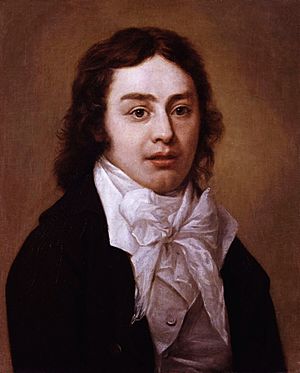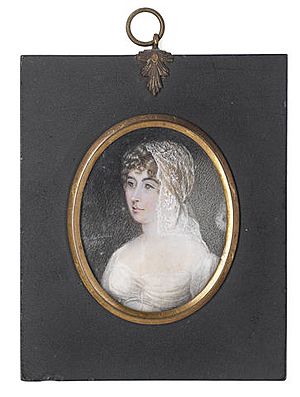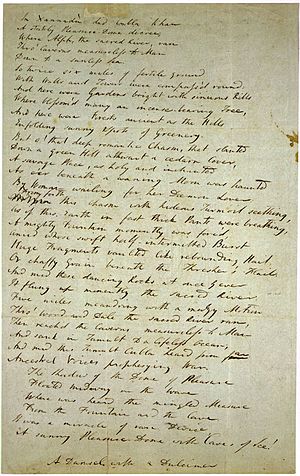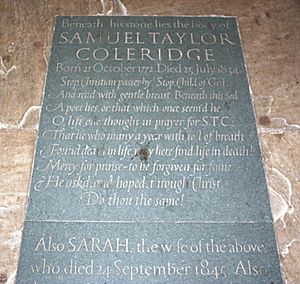Samuel Taylor Coleridge facts for kids
Quick facts for kids
Samuel Taylor Coleridge
|
|
|---|---|

Coleridge in 1795
|
|
| Born | 21 October 1772 Ottery St Mary, Devon, Great Britain |
| Died | 25 July 1834 (aged 61) Highgate, Middlesex, United Kingdom |
| Occupation |
|
| Alma mater | Jesus College, Cambridge |
| Literary movement | Romanticism |
| Notable works | The Rime of the Ancient Mariner, Kubla Khan, Christabel, Conversation poems, Biographia Literaria |
| Spouse | Sara Fricker |
| Children | Hartley Coleridge Berkeley Coleridge Sara Coleridge Derwent Coleridge |
| Relatives | James Coleridge (brother) |
| Signature | |
Samuel Taylor Coleridge (/ˈkoʊlərɪdʒ/ koh-LƏ-rij; 21 October 1772 – 25 July 1834) was an important English poet, literary critic, and philosopher. He helped start the Romantic Movement in England with his friend William Wordsworth. He was also part of a group called the Lake Poets.
Coleridge wrote famous poems like The Rime of the Ancient Mariner and Kubla Khan. He also wrote a major prose work called Biographia Literaria. His ideas about literature, especially about William Shakespeare, were very important. He also helped bring German philosophy to English-speaking countries. Coleridge even created many words and phrases we still use today, such as "suspension of disbelief". He greatly influenced American writers like Ralph Waldo Emerson.
Throughout his life, Coleridge faced many health challenges. He often felt unwell and had difficulties with his mood. These issues may have started from childhood illnesses.
Contents
Early Life and Education
Coleridge was born on 21 October 1772 in Ottery St Mary, England. His father, Reverend John Coleridge, was a respected vicar and headmaster of the King's School. Samuel was the youngest of ten children from his father's second marriage. He preferred reading to playing sports.
After his father died in 1781, 8-year-old Samuel was sent to Christ's Hospital. This was a charity school in London where he spent his childhood. There, he studied and wrote poetry, becoming friends with Charles Lamb. He loved reading books like Robinson Crusoe and Arabian Nights. He once wrote about how much he loved to read, saying he would "seize it, carry it by the wall, and bask, and read."
From 1791 to 1794, Coleridge attended Jesus College, Cambridge. In 1792, he won a gold medal for a poem he wrote against the slave trade. In 1793, he briefly left college and joined the army under a false name. His brothers helped him get discharged a few months later, and he returned to college. However, he never finished his degree.
New Ideas and Marriage



At Cambridge, Coleridge learned about new political and religious ideas. He met poet Robert Southey, and they planned to create a perfect community called Pantisocracy in Pennsylvania. This plan was later given up. In 1795, Coleridge married Sara Fricker, Southey's sister-in-law. Their marriage was not happy, and they eventually separated after having four children.
In 1796, Coleridge published his first book of poems, Poems on Various Subjects. He also started a short-lived journal called The Watchman.
Living in Somerset
The years 1797 and 1798 were very productive for Coleridge. He lived in Coleridge Cottage in Somerset. In 1795, he met the poet William Wordsworth and his sister Dorothy. Wordsworth moved nearby, and their friendship grew.
During this time, Coleridge wrote some of his most famous works. These include The Rime of the Ancient Mariner, the symbolic poem Kubla Khan, and the first part of Christabel. Kubla Khan is famously said to have been interrupted by a visitor. He also wrote his well-known "conversation poems" like This Lime-Tree Bower My Prison and Frost at Midnight.
In 1798, Coleridge and Wordsworth published a book of poems together called Lyrical Ballads. This book marked the beginning of the English Romantic age. Coleridge's The Rime of the Ancient Mariner was the longest and most praised poem in the collection.
Travels and Studies
In 1798, Coleridge traveled to Germany with the Wordsworths. He spent time in university towns and became very interested in German philosophy. He studied the ideas of thinkers like Immanuel Kant. After returning to England, he translated a play by the German poet Friedrich Schiller.
In 1800, Coleridge moved to Keswick in the Lake District to be near Wordsworth. He stayed with the Wordsworths for a while. During this period, he continued his philosophical studies and wrote the poem Dejection: An Ode. In 1802, he explored the Lake District fells, even making the first recorded descent of Scafell to Mickledore via Broad Stand.
Later Life and Burial
Samuel Taylor Coleridge is buried in the aisle of St. Michael's Parish Church in Highgate, London. He was originally buried elsewhere but was moved to St. Michael's in 1961. His grave is marked by a memorial slab that reads: "Beneath this stone lies the body of Samuel Taylor Coleridge." The church plans to restore the crypt and allow public access to his burial place.
Poetry and Influence
Coleridge is considered one of the most important figures in English poetry. His poems greatly influenced other major poets of his time. He was known for carefully revising his poems. Many believe that Coleridge inspired Wordsworth's idea of "Conversational Poetry." This style uses everyday language to express deep poetic ideas.
Coleridge was also a very important literary critic. His ideas about poetry have had a lasting impact on how literature is studied.
Famous Long Poems

Coleridge is perhaps best known for his longer poems. These include The Rime of the Ancient Mariner and Christabel. Even if you haven't read The Rime, you've likely heard phrases from it. For example, "an albatross around one's neck" and "water, water everywhere, nor any drop to drink." The poem also inspired the 1984 song by the band Iron Maiden. Christabel is known for its musical rhythm and Gothic story.
Kubla Khan, though shorter, is also very famous. Both Kubla Khan and Christabel were never fully finished. Critics praise them for their "exquisite metrical movement" and "imaginative phrasing."
Conversation Poems
|
|
These eight poems by Coleridge are often called "Conversation poems." This name was given to them in 1928. Many critics believe these poems are among Coleridge's best. They are also very influential.
These poems use a natural, easy style, almost like everyday talk. The last ten lines of Frost at Midnight are a great example of this. In the poem, the speaker talks to his sleeping infant son.
A literary critic named M. H. Abrams described these poems well. He said the speaker often starts by describing a landscape. This scene then leads to thoughts, memories, and feelings. Through this thinking, the speaker gains a new understanding or solves an emotional problem. The poem often ends back at the original scene, but with a deeper understanding. Abrams said Coleridge created a new type of "Romantic lyric" poem. This style influenced many later poets, including Wordsworth and John Keats.
Literary Criticism
Biographia Literaria
Besides his poetry, Coleridge wrote important works of literary criticism. One of his most famous is Biographia Literaria, published in 1817. This book shares his thoughts and ideas about literature. It includes parts of his own life story and his views on different literary principles. He discussed ideas from ancient thinkers like Aristotle to more modern ones like Immanuel Kant.
Many scholars consider Coleridge to be one of the greatest English critics. He was skilled at analyzing literature and connecting it to philosophical ideas.
Coleridge and Gothic Stories
Coleridge's poems like The Rime of the Ancient Mariner, Christabel, and Kubla Khan were very influential. They both drew inspiration from and helped popularize Gothic romance stories. These are tales that often include mystery, horror, and supernatural elements. Coleridge also used Gothic elements in his successful play Remorse.
Mary Shelley, who wrote Frankenstein, knew Coleridge well. She mentions The Rime of the Ancient Mariner in her novel. She even recalled hiding and listening to Coleridge recite the poem.
Religious Beliefs
Coleridge's father was an Anglican vicar. Coleridge himself worked as a Unitarian preacher for a time. He later returned to the Church of England in 1814. His writings on religion include Lay Sermons (1817) and Aids to Reflection (1825). He was an important figure in the Anglican theology of his day.
Political Thinking
Coleridge was also a political thinker. When he was young, he supported radical ideas and the French Revolution. However, he later developed more traditional views of society. He believed it was important for society to have a shared sense of community and good education. He also thought about how British history developed, especially its common laws.
Images for kids
-
Engraving of a scene from The Rime of the Ancient Mariner. The frozen crew and the albatross by Gustave Doré (1876)
 In Spanish: Samuel Taylor Coleridge para niños
In Spanish: Samuel Taylor Coleridge para niños
- Organic form
- Romantic epistemology
- Lake Poets





